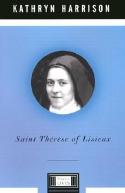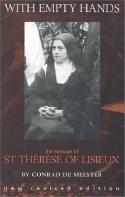Issue Date: May 21, 2004
Three authors on the faith of Thérèse Reviewed by JOHN McNAMEE Years ago, Jesuit Fr. William F. Lynch, the distinguished student and scholar of the literary imagination, said that you cannot set out to write a beautiful story. You can just tell the story, and, if you tell it well, it will be beautiful because of the truth that is there. An invocation of the Greek sense that what is true is also good and beautiful. Lynch would say that the deliberate invocation of sentiment spoils everything. Lynch came to mind with every page of the Harrison biography of Saint Thérèse of Lisieux. I read the book because earlier I had read and liked very much the biography of St. Augustine of Hippo by Garry Wills in the same Penguin Lives series. I did not recognize the name Kathryn Harrison. Both her photograph on the book jacket and what I afterward learned about her novels, her memoir Kiss and her other personal essays in The New Yorker and Harper’s make her a most unlikely biographer of Thérèse. By the method of William Lynch, Harrison’s biography works. She tells a story already familiar, at least in broad sweeps, to the reader in such a way that you find yourself asking: Where is the author going with this? Is she a Catholic? Is she sympathetic? Does she think the story of Thérèse as it unfolds is tragic or triumphant? With every page the attitude of the author seems one of detachment. She is simply putting Thérèse out there: Well, here she is. You interpret it. You have no idea what Harrison herself thinks. The sense is that Harrison is reading a story of Thérèse with you rather than telling you and that in the end her detachment leaves her and she is drawn in as so many have been: “A skeptic would say that Thérèse gave the name God to her internal strategy for survival. But perhaps every mystic finds the way to the divine through a rent in his or her psyche, a wound that might, in a lesser soul, result in self-absorption, vanity, avarice, envy.” Thérèse: The Saint Who Loved Us is a very different read. Author Cavanaugh writes for those who know little or nothing about Thérèse. No doubt there are new generations of Catholics out there who, less often in church than their parents or grandparents, might on the occasional visit notice that statue somewhere in the shadows of a young nun with a crucifix in her arms and a cascade of roses falling. That statue in a corner was pivotal for Cavanaugh himself early on in an unhappy childhood. Unable to pray in any familiar way, he noticed a plaster Thérèse in his parish church in New York and took her on as someone who could help him. She came through twice in crises. Over his lifetime, as his faith came and went with personal crises and world wars, Cavanaugh interpreted two other encounters with the relics of St. Thérèse as the saint personally and particularly intervening in his life to restore his floundering faith. The first crisis was in March 1945 in Paris at the end of World War II. Cavanaugh had been overseas for six months as part of a U.S.O. entertainment tour and was stalled in Paris awaiting orders to ship him home: “I’d lost my way, that’s the gist of it, not just from the war, but a long time ago, as a little boy, stumbling along blindly ever since, without any meaning to my life.” Prayer for help Wandering into Notre Dame Place, he suddenly came upon a procession with a casket of Thérèse’s relics being removed from Notre Dame to be returned to the basilica in Lisieux from which they had been taken to Notre Dame in Paris for safekeeping in anticipation of the Allied bombing of Normandy. “I didn’t choose, didn’t want to be here, yet here was exactly where I was. A prayer was a prayer, spoken or not. If my long-ago prayer for help was heard, who would have heard it if not the saint I’d called mine? And was it beyond the limits of credulity to consider that it was she, who by the punch of my finger on the Metro map, had fetched me here?” The next crisis was the terminal illness of a dear friend with whom Cavanaugh desperately wanted to share his recovered faith. Suddenly, he found himself in St. Patrick’s Cathedral just in time to venerate the relics of the saint, which had arrived from Brazil: “Fifty-four years ago, in the crowded square of Notre Dame in Paris, the relics had been carried past me in procession, on a day that would change my life forever. And here on this day, again, was I in the presence of my saint, my Thérèse, as for a long while I had sought to be close to her in spirit.” And here in Manhattan was Thérèse again to sustain Cavanaugh’s faith in the face of a friend’s illness and to enable him to write this book he long wanted to write as homage to her. His book is about the communion of saints and how Thérèse continues to let those roses fall in his direction when he needs them most. With Empty Hands: The Message of St. Thérèse of Lisieux by Fr. Conrad De Meester, is a new edition and translation of an earlier work in the light of new annotated editions of the saint’s work and recent research and commentary. The American publisher is the Institute of Carmelite Studies in Washington, responsible for so much scholarship on the Carmelite tradition. The book examines Thérèse in the light of Carmel and the image of desert and the night of faith and the purifications that the great mystic St. John of the Cross warns about and promises. The effort is also an attempt to understand the tinge of Jansenism in the era, the idea that a sister could offer herself as a victim to “God’s severe justice.” De Meester, a member of the Discalced Carmelites, is quite honest about this chill being present in Carmel as well as in the larger church, perhaps even more intensely so because of the intensity of Carmelite life. As with Harrison, De Meester can only admire the grace and intuition and intelligence that enabled Thérèse to wade through all these roadblocks to a Little Way that was really more a miracle of grace than something small or insignificant as Thérèse called her Way. The book is suffused with passages from the saint herself that document her miraculous growth in so few years. With Empty Hands is particularly a book for those who want to understand Thérèse in her own words or in the context of her Carmelite tradition. Here and there one comes upon surprises: “Several commentators have noticed the ecumenical tendency of Thérèse doctrine. This young girl was a deeply believing Catholic, dedicated in obedience to the authority of the church. In lifestyle and personal behavior she was immersed in the Catholic life of her time. Nevertheless, the way in which she conceived of the life of faith brought her interestingly close to the Lutheran notion of salvation through faith alone.” Differing sensibilities These three books speak to very different readers. Harrison seems to write for a modern secular sensibility. About Thérèse’s anguished desolation, she writes, “At last she has taken her place among us, not so much revealed as human as given birth to her naked self, plummeting to earth, wet and new and terrified. If we allow her to become a saint, if we believe in her, it’s because here, finally, she has achieved mortality.” Cavanaugh’s endangered and fragile faith is salvaged by incidents he perceived as Thérèse intervening in his life: “The image of the little white flower materialized before me, and somehow I knew that I wasn’t on the wrong track with my book and must write the story of Thérèse as I perceived it, from my own perspective. She was the saint who loved us.” With Cavanaugh I have been there, seen her statue or mysteriously came upon some roses and read the random event just as Cavanaugh did as some light on my darkness. The famous line from the Song of Bernadette comes to mind: For those who believe, no explanation is necessary. For those who do not, none is possible. The value of the De Meester book is that the author is so familiar with the works of Thérèse herself, the several manuscripts of the autobiography, the letters, the documented testimony of others, the background of Carmel. With Empty Hands might be a better way to wade seriously into the Thérèse story rather than by way of Thérèse’s own narrative. Fr. John McNamee is the pastor of St Malachy Church in Philadelphia and the author of Diary of a City Priest; Clay Vessels and Other Poems; and Endurance, The Rhythm of Faith, all published by Sheed and Ward. National Catholic Reporter, May 21, 2004 |


